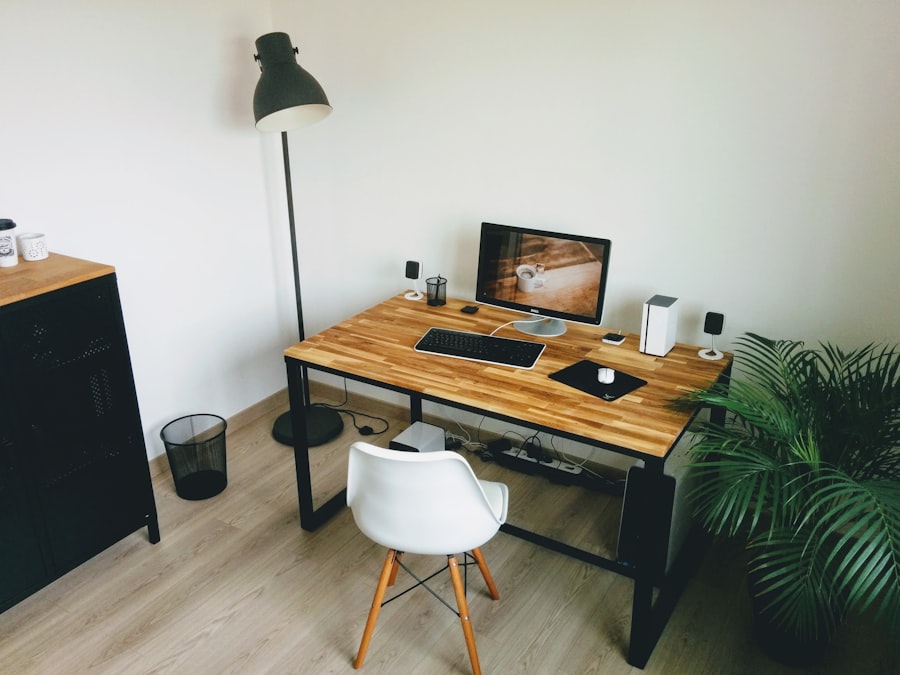Adjustable height desks have surged in popularity over the past decade, and for good reason. One of the primary benefits of these desks is their ability to promote better posture. Traditional desks often encourage slouching or leaning forward, which can lead to chronic back pain and other musculoskeletal issues.
In contrast, adjustable height desks allow users to customize their workspace to fit their individual body dimensions, enabling them to maintain a neutral spine position whether sitting or standing. This adaptability can significantly reduce the risk of developing posture-related ailments over time. Moreover, adjustable height desks can enhance productivity.
Studies have shown that employees who alternate between sitting and standing tend to experience increased energy levels and improved focus. The ability to change positions throughout the day can help combat fatigue and boredom, which are common pitfalls in sedentary work environments. By allowing for movement and variation in posture, these desks can create a more dynamic work atmosphere that fosters creativity and engagement.
Key Takeaways
- Adjustable height desks promote better posture and reduce the risk of musculoskeletal issues.
- Consider factors such as height range, weight capacity, and ease of adjustment when choosing an adjustable height desk.
- Design an ergonomic workspace by positioning the desk at elbow height and using an adjustable chair and monitor stand.
- Find the right balance between sitting and standing to avoid fatigue and discomfort with an adjustable height desk.
- Set up your desk for maximum comfort and productivity by adjusting the height, using an anti-fatigue mat, and incorporating movement breaks.
How to Choose the Right Adjustable Height Desk for Your Needs
Height Adjustment Range
The range of height adjustments available is a crucial factor to consider. Desks that can accommodate a wide range of heights are ideal for users of varying statures, ensuring that both sitting and standing positions are comfortable. For instance, a desk that adjusts from 24 inches to 50 inches can cater to a broader audience than one with a more limited range.
Stability and Durability
Another critical factor is the desk’s stability during height adjustments. A wobbly desk can be distracting and may lead to spills or accidents, particularly when using a laptop or other devices. It’s advisable to look for desks with sturdy frames and high-quality materials that can withstand regular use without compromising stability.
Weight Capacity and Equipment Support
Additionally, consider the weight capacity of the desk; it should be able to support all your equipment, including monitors, keyboards, and any other accessories you may use.
Designing an Ergonomic Workspace with Adjustable Height Desks

Creating an ergonomic workspace is essential for maximizing the benefits of an adjustable height desk. Ergonomics focuses on designing workspaces that fit the user’s needs, thereby reducing strain and enhancing comfort. When setting up an adjustable height desk, it’s crucial to position your monitor at eye level to prevent neck strain.
Ideally, the top of the screen should be at or slightly below eye level, with the screen about an arm’s length away. This positioning helps maintain a neutral neck posture whether sitting or standing. In addition to monitor placement, keyboard and mouse positioning is vital for ergonomic comfort.
When seated, your elbows should be at a 90-degree angle, with your wrists straight while typing. For standing positions, it’s important to keep your elbows close to your body and your wrists in a neutral position. Using an ergonomic keyboard tray or mouse pad with wrist support can further enhance comfort and reduce the risk of repetitive strain injuries.
The debate between standing and sitting while working has garnered significant attention in recent years. While standing desks offer numerous benefits, such as increased energy and reduced sedentary time, prolonged standing can also lead to discomfort and fatigue. Therefore, finding the right balance between sitting and standing is crucial for overall well-being.
Research suggests that alternating between positions every 30 to 60 minutes can optimize comfort and productivity. To facilitate this balance, many users find it helpful to set reminders or use apps that prompt them to change positions throughout the day. Additionally, incorporating movement during breaks—such as stretching or walking—can further enhance circulation and reduce stiffness.
By being mindful of how long one remains in either position, individuals can create a more sustainable work routine that promotes health without sacrificing productivity.
Tips for Setting Up Your Adjustable Height Desk for Maximum Comfort and Productivity
Setting up an adjustable height desk requires careful consideration of various factors to ensure maximum comfort and productivity. First, it’s essential to adjust the desk height according to your body dimensions. When seated, your feet should rest flat on the floor or on a footrest, with your knees at a 90-degree angle.
When standing, your elbows should also be at a 90-degree angle while typing, with your wrists straight and hands hovering just above the keyboard. In addition to height adjustments, consider the arrangement of your workspace. Keep frequently used items within arm’s reach to minimize unnecessary stretching or twisting.
This includes placing your mouse close to your keyboard and ensuring that documents are easily accessible without straining your neck or back. Furthermore, personalizing your workspace with items that inspire you—such as plants or artwork—can enhance your mood and motivation throughout the day.
Incorporating Movement into Your Workday with an Adjustable Height Desk
Scheduling Breaks for Movement
One effective strategy is to schedule short breaks every hour to stand up, stretch, or take a brief walk around the office or home. These breaks not only help alleviate physical tension but also provide mental refreshment, allowing you to return to tasks with renewed focus.
Using Movement-Encouraging Tools
Another way to integrate movement is by using a balance board or anti-fatigue mat while standing at your desk. These tools encourage subtle movements that engage core muscles and improve balance while reducing fatigue associated with prolonged standing.
Movement and Creative Thinking
Additionally, consider using walking meetings or phone calls as opportunities to move around rather than remaining seated at your desk. This approach not only promotes physical activity but can also stimulate creative thinking through changes in environment.
The Impact of Adjustable Height Desks on Health and Well-being

The impact of adjustable height desks on health and well-being extends beyond mere comfort; they play a significant role in promoting overall physical health. Research has indicated that reducing sedentary time can lower the risk of chronic conditions such as obesity, diabetes, and cardiovascular disease. By allowing users to alternate between sitting and standing throughout the day, these desks contribute to increased energy expenditure compared to traditional desks.
Moreover, mental health benefits are also associated with adjustable height desks. The ability to change positions can alleviate feelings of fatigue and monotony often experienced in sedentary work environments. Enhanced mood and reduced stress levels have been reported by individuals who utilize these desks effectively.
The flexibility they offer encourages a more active lifestyle, which is crucial in combating the negative effects of prolonged sitting.
Customizing Your Workspace with Accessories for Adjustable Height Desks
Customizing your workspace with accessories can significantly enhance the functionality and comfort of an adjustable height desk. One popular accessory is an ergonomic chair that provides adequate lumbar support when seated. A chair with adjustable features allows users to tailor their seating position for optimal comfort while working at their desk.
Additionally, monitor arms are excellent tools for optimizing screen placement without taking up valuable desk space. These arms allow users to adjust their monitors’ height and angle easily, promoting better posture and reducing neck strain. Other accessories such as cable management solutions help keep cords organized and out of sight, contributing to a cleaner workspace that minimizes distractions.
Overcoming Common Challenges When Transitioning to an Adjustable Height Desk
Transitioning to an adjustable height desk can present several challenges that users must navigate for a successful adjustment period. One common issue is discomfort during prolonged standing sessions, particularly for those who are accustomed to sitting for extended periods. To mitigate this discomfort, it’s advisable to gradually increase standing time rather than making abrupt changes in posture throughout the day.
Another challenge may involve adjusting one’s workflow around the new desk setup. Users might find themselves distracted by the novelty of standing while working or may struggle with maintaining focus during transitions between sitting and standing positions. Establishing a routine that incorporates regular breaks and movement can help ease this transition while promoting productivity.
Creating a Productive and Healthy Work Environment with Adjustable Height Desks
Creating a productive and healthy work environment involves more than just having an adjustable height desk; it requires a holistic approach that considers various elements of workplace design and culture. Encouraging open communication among team members about their workspace preferences can foster a supportive atmosphere where everyone feels comfortable discussing their needs. Incorporating wellness initiatives within the workplace can further enhance the benefits of adjustable height desks.
Programs that promote physical activity—such as group walks during lunch breaks or fitness challenges—can encourage employees to take advantage of their desks’ flexibility while fostering camaraderie among colleagues.
The Future of Workspaces: How Adjustable Height Desks are Changing the Way We Work
The future of workspaces is increasingly leaning towards flexibility and adaptability, with adjustable height desks at the forefront of this evolution. As organizations recognize the importance of employee well-being in driving productivity, there is a growing trend towards creating environments that prioritize health through ergonomic design. Moreover, advancements in technology are likely to further enhance the functionality of adjustable height desks in the coming years.
Features such as built-in sensors that remind users when to change positions or integrated health tracking capabilities could become standard in modern office furniture design. As remote work continues to gain traction, individuals will also seek out these adaptable solutions for their home offices, leading to a broader acceptance of flexible work arrangements across various industries. In conclusion, adjustable height desks represent a significant shift in how we approach our work environments, emphasizing health, comfort, and productivity in equal measure.
As more individuals embrace this innovative furniture solution, it is clear that adjustable height desks will play a pivotal role in shaping the future of workspaces worldwide.
If you are interested in desks with adjustable height, you may also want to read about the importance of workstation health and safety. This article discusses how proper ergonomics and office furniture can contribute to a safe and healthy work environment. Additionally, learning about ergonomic office furniture from this source can help you understand the benefits of investing in adjustable desks for your modern office workstations.


